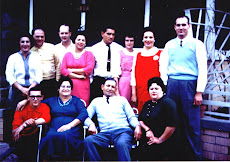
Photo: My mom, Toni, with a feline friend on the front lawn of the Tivoli Hotel, early 1950s.
The Tivoli Hotel, located on East Beach, was not exactly on the Point, but it was a local landmark with a lot of significance for East Biloxi residents.
Built in 1927, it was one of the Coast’s grand resort hotels, along with the Buena Vista, the Broadwater Beach and the White House, that survived (although admittedly not very well preserved) into the 21st century. Back in its day, the hotel was the last name in luxury. According to the newspaper accounts the Tivoli opened 'in a whirl of dancing, a kaleidoscopic blaze of color and a musical festival of barbaric jazz.'
Guests from all over the country came to stay in its elegantly appointed 64 guest apartments. During the roaring 20s when the Mississippi Coast was considered America’s Riviera and Biloxi was “Sin City,” guests could gamble right in the lobby.
By the time I became a regular visitor in the early 1970s, the hotel, then known as the Trade Winds, had started its long decline into seediness. Still the decaying property possessed a glamour that --even to my teen-aged eyes -- the more modern budget hotels springing up along the Coast could never rival.
My sister and I had grown up as “hotel brats” due to my father’s association with hotel restaurant management. When he retired, he started a part-time catering business out of the Tivoli. We made ourselves right at home.
During the summer, we often accompanied him to the hotel. We ate breakfast – usually grits and hot chocolate -- in the Tivoli Room, a cheerful, cozy and warm dining spot with yellow and white gingham café curtains and window boxes filled with artificial daffodils. A decade later, it was the first home for Sumi’s Japanese restaurant.
We swam in the Tivoli’s pool. I loved changing in the ladies’ lounge with its ultra-feminine décor of white wicker furniture with pink flowered cushions. I coveted the chaise or swooning couch.
Many an East Biloxi wedding reception was held in the hotel’s Wedgewood ballroom. With its soaring ceilings, elegant moldings and fancy chandeliers, the room was everything a bride could want for her wedding, right down to the grillwork balcony perfect for tossing a bouquet. My sister and I earned pocket money by trimming crusts off those dainty egg, chicken and tuna salad sandwiches for the wedding reception.
On the other side of the spacious lobby, the Gaslight Room, a fin de siècle-inspired affair decorated in opulent red velvet, and drawings of Gibson girls, served as the venue for a local dinner theater. In my early teens, I landed a role in the chorus of the company’s production of Carousel. Unfortunately, our production had to be scrapped when the adjacent hotel bar expanded and took over our stage.
Eventually, the Tivoli became decrepit, a home for prostitutes, drug dealers and other people on the downslide. There was at least one suicide there.
It remained on historic preservation lists. There were occasional plans to restore it as a resort, a half-way house, condos. Nothing ever came of those plans.
On August 29, 2005, several people took refuge in the still-sturdy building as Hurricane Katrina approached. Eight of them lost their lives in the storm surge that enveloped East Biloxi.
In 2006, the remnants of the Tivoli, were torn down. It was a sad day, but there were so many sad days in the months following the storm.
This recipe is inspired by chicken salad sandwiches made for Tivoli brides. We used a typical Southern chicken salad -- finely minced chicken and veggies with lots of mayonnaise -- on white bread. Personally, I prefer more robust chicken salad sandwiches. The recipe below is adapted from one in Faith Ford's cookbook "Cooking with Faith" (a great source for Southern recipes. I love almost everything I've made from it). To save time, buy a rotisserie chicken.
Faith Ford's Chicken Salad Sandwich
2 cups chopped, cooked chicken (rotisserie chicken works great)
2 celery stalks, chopped
1 chopped carrot
1/2 small red onion chopped
1/4 cup chopped toasted pecans
1 T chopped fresh parsley
1 T chopped fresh cilantro (if you don't like cilantro, substitute basil, oregano, thyme or dill, whatever herb you like)
1/2 cup mayonnaise (light or regular)
1/4 sweet pickle relish
2 T freshly squeezed lime juice (lemon if you prefer)
1 T Dijon mustard
1/4 teaspoon black pepper
Salt
8 slices sourdough bread
OPTIONAL: 2 roasted bell peppers (better if you roast your own, but you can use jarred)
2 cups of shredded red leaf or green leaf lettuce)
In a medium bowl, mix together chicken, celery, onion, carrot, pecans, parsley and cilantro (or other herb). In a separate small bowl, stir together the mayonnaise, pickle relish, lime (or lemon) juice, mustard and pepper. Pour the dressing over the chicken mixture and toss thoroughly. Season with salt and pepper to taste. May be made 1 day ahead. Store, covered, in the refrigerator.
Toast the bread. Place 1/2 to 2/3 cup of chicken salad on each sandwich. Put half a roasted red pepper on top of the chicken salad, followed by lettuce. Put other slice of bread on top. Slice in half.
Makes 8 sandwiches











